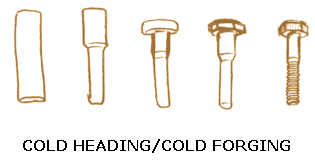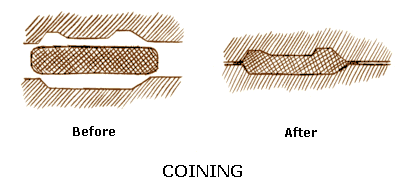Cold Forging
 Cold Forging is a cold working process where the material is squeezed into a die and the finished parts assume the shape of the die. This process is also known as Cold Heading.
Cold Forging is a cold working process where the material is squeezed into a die and the finished parts assume the shape of the die. This process is also known as Cold Heading.
Bar stock or wire stock is fed into a die and is squeezed into the closed die. The resultant part is a nail, a bolt or a screw with the head. A subsequent cold heading operation forms other features on the head such as knurls or slots for screw drivers etc. the shaping rod stock by forming the head as in rivets, bolts, nails and other fasteners. This process can be highly automated and parts can be made economically.
Hubbing
Hubbing is a process to make recessed cavities in female tooling dies.
The process begins with a male tool, the hub, which is made with the desired profile then hardened. The hub is then slowly pressed (using hydraulic force) into the desired tooling cavity hole to reproduce the inverse of the profiles.
The metal displaced from the cavity is removed by machining, using a fly cutter on a milling machine or grinding it on a surface grinder.
This is a good alternative to the conventional die sinking process where the female tool cavity is machined. In hubbing, the male tool is machined and external machining is easier than internal machining.
This is often used to produce plastic extrusion dies economically.
Peening
Cold working can improve or alter the surfaces of metal products. Peening is a cold working process where the surface of the metal is blasted by shot pellets.
This induces compressive stress in the region just below the skin to compensate for the stretching of the skin. When a tensile load is applied on this residual compressed load, the net effect is a reduced amount of stress on the part. This makes the metal well suited for fatigue applications which involve cyclic loads-such as gears, crankshafts etc.
Most weldment surfaces are under tension due to shrinkage after being exposed to welding heat. Peening can reduce tensile stress by inducing compressive stress on the part. In this type of application peening is done by using hammers.
Sizing
Sizing is the squeezing of a specific area of a ductile casting, a forging, or a powder metallurgy to bring it to the desired thickness.
This allows the use of lower cost processes and yet achieve the tolerances that may be needed on a part.
This is useful for areas such as bosses, flanges and similar parts that need to be of a certain specified thickness.
Swaging Swaging is a process that is used to reduce or increase the diameter of tubes and/or rods.
Swaging is a process that is used to reduce or increase the diameter of tubes and/or rods.
This is done by placing the tube or rod inside a die that applies compressive force by hammering radially. This can be further expanded by placing a mandrel inside the tube and applying radial compressive forces on the outer diameter. Thus, the inner diameter can be a different shape, for example a hexagon, and the outer is still circular.
Thread Rolling
Thread Rolling process is used for making external threads.
A die, which is a hardened tool with the thread profile, is pressed on to a rotating workpiece. As the force is gradually increased, the thread profile is transferred to the workpiece. This process produces screws with greater strength than machined threads due to the cold working, as well as better material yield.
Thread Rolling

Thread Rolling process is used for making external threads.
A die, which is a hardened tool with the thread profile, is pressed on to a rotating workpiece. As the force is gradually increased, the thread profile is transferred to the workpiece. This process produces screws with greater strength than machined threads due to the cold working, as well as better material yield.
Coining
Introduction Coining is the squeezing of metal while it is confined in a closed set of dies.A workpiece is placed a confined die. A movable punch is located within the die. The action of this punch cold works the material and can form intricate features.This process is used to produce coins, medallions and other similar products on flat stock with relief features. Very fine detail can be reproduced. Pressures as high as 1375 MPa (200,000 psi) is required to generate very fine features.
Coining is the squeezing of metal while it is confined in a closed set of dies.A workpiece is placed a confined die. A movable punch is located within the die. The action of this punch cold works the material and can form intricate features.This process is used to produce coins, medallions and other similar products on flat stock with relief features. Very fine detail can be reproduced. Pressures as high as 1375 MPa (200,000 psi) is required to generate very fine features.

